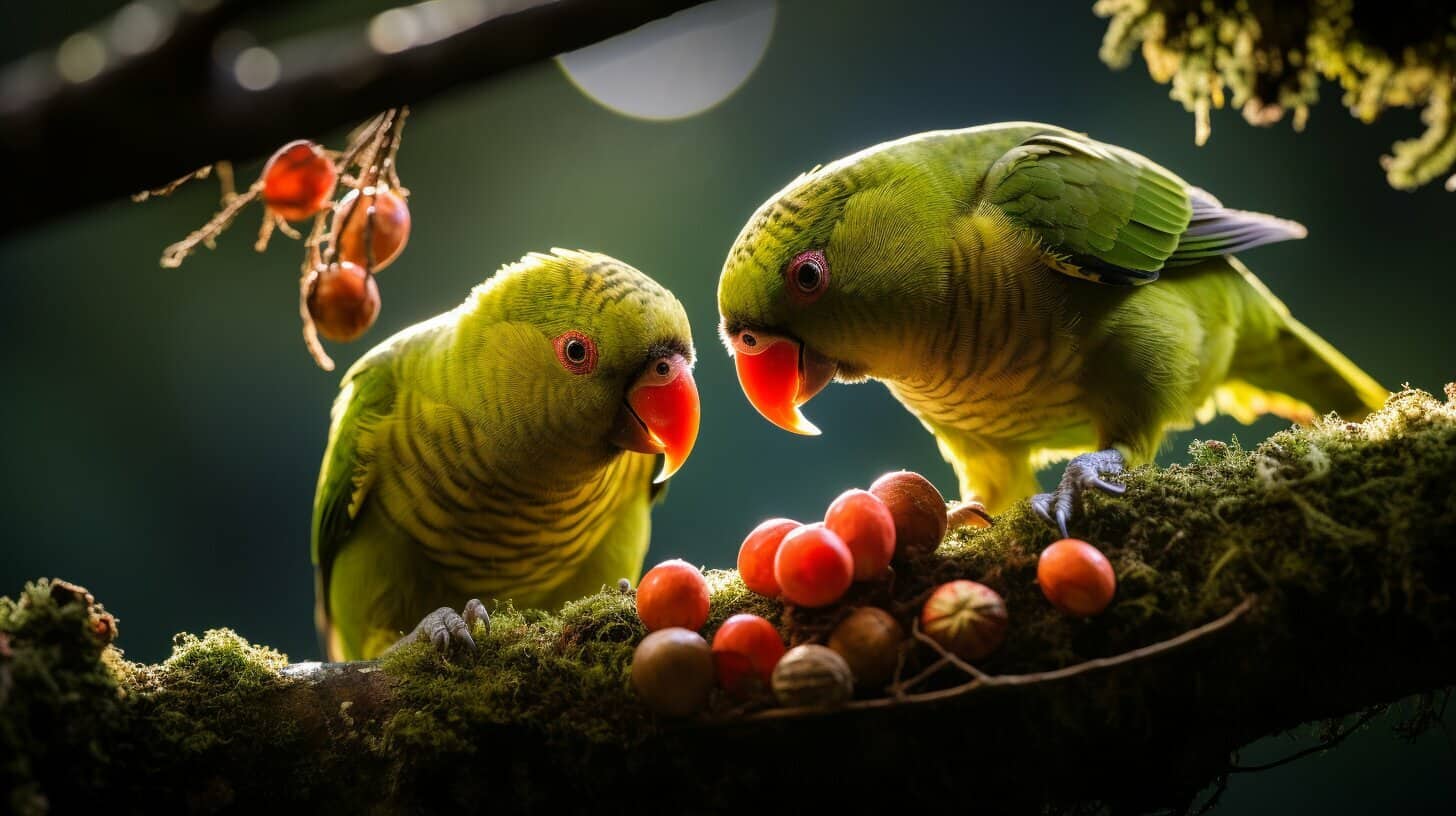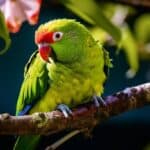Kakarikis are a small parrot species known for their vibrant plumage and playful personality. If you are a pet owner or just fascinated by these birds, you may wonder how often they breed in a year. The answer, as with most things in nature, is not straightforward. Several factors influence the breeding frequency of Kakarikis, and the number of times they breed can vary depending on their environment and other circumstances.
In this article, we will explore the breeding habits of Kakarikis and provide insights into their reproductive behaviour. We will examine the factors that influence their breeding frequency and guide breeding management for those who own these birds. Additionally, we will delve into the breeding patterns of different species of Kakarikis and offer solutions to common reproductive challenges these birds face.
How many times a year do kakarikis breed? Kakarikis can breed up to 4 times a year. These vibrant parakeets have a high breeding capacity when kept in optimal conditions. With a short incubation period, coupled with their hardy nature, they rapidly reproduce, making them popular among breeders and pet enthusiasts alike.
Key Takeaways
- Kakarikis breed multiple times a year, but the exact number can vary depending on various factors.
- Breeding cycles, annual breeding habits, and reproductive behaviour are significant factors that can influence Kakarikis’ breeding frequency.
- Captive Kakarikis may have different breeding patterns than their wild counterparts, and proper breeding management is essential for their health and welfare.
- Different species of Kakarikis have unique breeding habits, and it is crucial to understand these variations to encourage successful breeding.
Understanding Kakarikis’ Breeding Cycles
Kakarikis are known for their frequent breeding cycles, with some individuals breeding multiple times in a year. However, the exact breeding frequency can vary based on several factors, including environmental conditions, availability of resources, and social dynamics within their population.
Typically, Kakarikis breed from late winter to early summer, with the exact timing of breeding dependent on the availability of food and nesting sites. During this time, males will begin to display courtship behavior, including singing, dancing, and offering food to potential mates.
Once a pair has been established, they will build a nest in a suitable location, such as a tree hollow or nest box. The female will lay a clutch of eggs, hatching after approximately 20 days of incubation.
After hatching, the parents will care for the chicks for several weeks, providing them with food and protection until they are ready to fledge. Once the chicks have left the nest, the parents may continue to care for them for a brief period before beginning the breeding cycle again.
Factors Influencing Kakarikis’ Breeding Frequency
Several factors can influence the breeding frequency of Kakarikis, including:
- Availability of food and water
- Availability of nesting sites
- Social dynamics within the population
- Environmental conditions, such as temperature and rainfall
When these factors are favourable, Kakarikis may breed multiple times a year, while adverse conditions may result in a reduced breeding frequency or skipped breeding season.
The Annual Breeding Habits of Kakarikis
Kakarikis, known as New Zealand parakeets, have complex and fascinating breeding habits. While these birds can breed throughout the year, they tend to have a defined breeding season in the wild, with variations observed across different populations.
Kakarikis’ breeding season typically occurs between August and January in the Southern Hemisphere. Within this period, the birds may mate and breed multiple times. In contrast, breeding usually occurs between February and July in the Northern Hemisphere.
During the breeding season, Kakarikis engage in courtship displays, including mutual preening and feeding, and vocalizations to attract a mate. They may also engage in aggressive displays to defend their territory and mating rights.
Once a pair is formed, Kakarikis will work together to build and maintain their nest, found in tree hollows or crevices. The female lays a clutch of 4-7 eggs, and both parents take turns incubating them for around 21-29 days.
After hatching, the chicks are fed by both parents, with the female providing regurgitated food while the male brings in additional food sources. The chicks fledge the nest after around 30 days, although they may continue to rely on their parents for up to 8 weeks.
It is important to note that the breeding habits of Kakarikis can vary depending on their environment and population. For example, in areas with a stable food supply, breeding may occur throughout the year, while in other areas with limited resources, breeding may only occur during specific times of the year.
Overall, understanding Kakarikis’ annual breeding habits is essential for researchers and pet owners alike. By knowing when and how these birds breed, we can work to promote their welfare and conservation.
Reproductive Behavior of Kakarikis
Kakarikis are known for their colourful plumage and playful personalities, but their reproductive behaviour is just as fascinating. Like many bird species, Kakarikis engage in courtship displays and mate selection rituals to find a suitable partner for breeding.
Male Kakarikis often initiate courtship by performing acrobatic displays and singing to attract a female’s attention. If the female is interested, she may respond by preening or posturing in front of the male.
Once a pair has formed, they may begin the nest building process. Kakarikis are cavity nesters, meaning they prefer to nest in hollow trees or crevices. In captivity, they may use specially designed nesting boxes.
The female Kakariki is responsible for most of the incubation and care of the eggs and chicks. However, the male may assist with feeding and protecting the young.
Overall, the reproductive behaviour of Kakarikis is complex and intriguing. By understanding their courtship rituals and nesting habits, we can better support their breeding success in wild and captive populations.
Factors Influencing Kakarikis’ Breeding Frequency
Kakarikis’ breeding frequency can be influenced by various factors, ranging from environmental conditions to social dynamics within their population. Understanding these factors is crucial for pet owners looking to encourage breeding in their Kakarikis.
Environmental conditions: Kakarikis are more likely to breed during optimal weather conditions, such as mild temperatures and adequate rainfall. Conversely, extreme heat or cold can reduce their breeding frequency. The availability of food and nesting resources can also impact their breeding success.
Social dynamics: Kakarikis are social birds that live in flocks. Breeding frequency can be influenced by the composition of the group, including the number of males and females, age distribution, and hierarchy within the flock. A dominant male may mate with multiple females, while subordinate males may struggle to find a mate.
Genetics: Some Kakariki species may have genetic predispositions that affect their breeding frequency. For example, captive breeding programs may select certain traits that enhance reproductive success, leading to increased breeding frequency over time.
Stress: Stressful events, such as relocation or introduction to a new environment, can reduce breeding frequency in Kakarikis. Owners should minimize stressors and provide a comfortable, stable living environment for their birds.
By understanding these factors, pet owners can create an optimal breeding environment for their Kakarikis and increase the likelihood of successful breeding.
Breeding Patterns in Captive Kakarikis
Captive Kakarikis can have different breeding patterns than their wild counterparts due to environmental and social dynamics variations. Captive breeding can be more successful as it allows pet owners to control and optimize breeding conditions.
To encourage breeding in captive Kakarikis, providing them with a warm and comfortable environment that mimics their natural habitat is essential. Pet owners should ensure that Kakarikis have access to clean water, a healthy diet, and sufficient space to move around and exercise.
Providing a nesting box or suitable materials can also promote breeding behaviour in Kakarikis. The box should be placed in a quiet and secluded area to provide privacy for the birds. Owners should also monitor the breeding behaviour of their birds and address any issues promptly to ensure a successful breeding process.
| Tip | Description |
|---|---|
| Monitor Breeding Behavior | Observe the behaviour of your Kakarikis to identify signs of breeding and address any problems that may arise. |
| Provide a Warm Environment | Keep your Kakarikis in a warm and comfortable environment to promote breeding behaviour. |
| Offer a Healthy Diet | Feed your Kakarikis a balanced diet with fresh fruits, vegetables, and seeds to ensure proper nutrition. |
| Provide a Nesting Box | Offer a nesting box and suitable materials for your Kakarikis to build their nests. |
It is important to note that breeding captive Kakarikis should be done responsibly, ensuring the health and well-being of the birds. Overbreeding can cause stress and health issues for the birds, so owners should carefully manage the breeding process.
By following best practices for breeding management, pet owners can successfully breed captive Kakarikis and contribute to the conservation of this unique species.
Reproductive Challenges and Solutions for Kakarikis
Kakarikis are known for their high reproductive rate, but they can still face certain challenges regarding breeding. Some common issues include infertility, poor egg quality, and difficulties hatching eggs. Fortunately, several solutions can help overcome these challenges and ensure a successful breeding season.
Infertility: If a pair of Kakarikis fails to produce viable offspring, it may be due to infertility in one or both birds. One potential solution is to introduce a new mate, as sometimes a change in partner can improve fertility rates. It’s also important to ensure that both birds are healthy and receiving proper nutrition.
Poor egg quality: Another common challenge is poor egg quality, leading to low hatch rates. This could be caused by various factors, such as inadequate nutrition or age-related decline in fertility. One solution is providing a well-balanced diet with plenty of fresh fruits and vegetables. It’s also recommended only to breed Kakarikis that are in the prime of their reproductive years.
Hatching difficulties: Sometimes, Kakarikis experience difficulties hatching their eggs, such as prolonged incubation times or chicks that fail to hatch. This could indicate improper incubation conditions, such as incorrect temperature or humidity levels. To address this issue, monitoring the incubation conditions closely and adjusting them as needed to ensure optimal hatching conditions is important.
Overall, addressing these common reproductive challenges requires careful monitoring and attention to the needs of the birds. Providing proper nutrition, introducing new mates as needed, and maintaining optimal breeding conditions can overcome these challenges and ensure a successful breeding season for your Kakarikis.
Breeding Management for Kakarikis
Breeding Kakarikis can be a fulfilling and rewarding experience for pet owners. However, it is essential to provide optimal breeding management to ensure the health and well-being of the birds, as well as increase the likelihood of successful breeding. Here are some key factors to consider:
| Factor | Management Consideration |
|---|---|
| Nesting Conditions | Kakarikis require a suitable nesting area, such as a nest box or nesting log, that is large enough for the birds to move around in comfortably and lay eggs. To minimise disturbances, the nesting area should also be placed in a quiet and secluded location. |
| Diet | A balanced and nutritious diet is essential for optimal breeding. Kakarikis should be fed a diet that includes a variety of fruits, vegetables, seeds, and pellets. It is also important to ensure that the birds have access to clean and fresh water at all times. |
| Monitoring | Regular monitoring of the breeding process is essential to ensure that the birds are healthy and the breeding is progressing as expected. This can include checking the nesting area for cleanliness, observing the birds’ behaviour, and monitoring egg development. |
It is also important to note that responsible breeding practices are crucial for the health and welfare of the birds. This includes avoiding inbreeding, ensuring that the birds are of appropriate age and health for breeding, and providing adequate space and resources.
Overall, by providing optimal breeding management, pet owners can increase the likelihood of successful breeding and help promote the health and well-being of their Kakarikis.
Breeding Frequency in Different Kakariki Species
Kakarikis are a diverse group of parrots, with several distinct species found in different regions of New Zealand. While all Kakariki species follow a similar breeding cycle, there are some notable differences in their frequency and behaviour.
The Yellow-crowned Kakariki, for example, is known to breed up to four times a year, producing clutches of 4-6 eggs per breeding cycle. In contrast, the Red-crowned Kakariki typically breeds only once or twice a year, with 3-5 eggs clutches.
The Orange-fronted Kakariki, considered an endangered species, has a much lower breeding frequency, typically breeding only once a year with a clutch size of 3-5 eggs. Similarly, the critically endangered Forbes’ Parakeet breeds only once per year, with clutches of 2-4 eggs.
Overall, the breeding frequency of Kakariki species is influenced by various factors, including their habitat, food availability, and social dynamics. It is important to appreciate the unique breeding patterns of each species to support their conservation and breeding management.
Conclusion
In conclusion, the breeding habits of Kakarikis are influenced by various factors such as environmental conditions, availability of resources, and social dynamics within their population. While the breeding frequency of Kakarikis varies among different species, it is generally observed that they breed once or twice a year. Understanding their breeding cycles and reproductive behaviour can help pet owners manage their breeding and ensure their health and welfare.
Captive breeding of Kakarikis is an important responsibility that requires proper management, nutrition, and monitoring to avoid health issues and ensure successful reproduction. It is crucial to address any reproductive challenges that may arise, such as infertility or failure to produce viable offspring. Moreover, responsible breeding practices must be followed to ensure the welfare of the birds.
Overall, the breeding habits of Kakarikis are an intriguing aspect of their behaviour. While there is still much to learn about their reproductive patterns, studying their breeding behaviour is vital for the conservation of the species and the welfare of captive individuals.
FAQ
Q: How many times a year do Kakarikis breed?
A: Under optimal conditions, Kakarikis can breed multiple times a year. However, it’s important to understand that allowing Kakarikis to breed constantly can be detrimnental to their health.
Q: What are the breeding cycles of Kakarikis?
A: Kakarikis have specific breeding cycles that are influenced by factors such as temperature, daylight hours, and availability of resources. They generally have a defined breeding season during which they mate and raise their offspring.
Q: What are the annual breeding habits of Kakarikis?
A: Kakarikis have a specific breeding season that is typically annual. During this time, they engage in courtship displays, mate selection, and nest-building activities. The breeding season may vary in timing and duration depending on the species and environmental conditions.
Q: What is the reproductive behaviour of Kakarikis?
A: Kakarikis exhibit reproductive behaviours such as courtship displays, vocalizations, and nest-building. Both male and female Kakarikis participate in the breeding process, with the male often engaging in elaborate displays to attract a mate.
Q: What factors influence Kakarikis’ breeding frequency?
A: Several factors can influence the breeding frequency of Kakarikis, including environmental conditions, availability of resources such as food and nesting sites, and social dynamics within their population. These factors can impact the number of times Kakarikis breed in a year.
Q: What are the breeding patterns in captive Kakarikis?
A: Captive Kakarikis may have different breeding patterns than their wild counterparts due to the controlled environment. However, providing appropriate nesting conditions, a balanced diet, and encouraging social interactions can help stimulate breeding in captive Kakarikis.
Q: What are the reproductive challenges faced by Kakarikis?
A: Kakarikis may encounter reproductive challenges such as infertility or difficulty producing viable offspring. These challenges can be attributed to various factors, including genetic factors, age, and health issues. Consulting with an avian veterinarian can help identify and address these challenges.
Q: How can the breeding of Kakarikis be managed?
A: Breeding management for Kakarikis involves ensuring optimal nesting conditions, providing a nutritious diet, and monitoring the birds’ health and behaviour. Responsible breeding practices, such as avoiding inbreeding and promoting genetic diversity, are also essential for the well-being of the birds.
Q: Do different species of Kakarikis have different breeding frequencies?
A: Yes, different species of Kakarikis may have varying breeding frequencies. Some species may breed once a year, while others may breed multiple times or have irregular breeding patterns. Understanding the specific breeding habits of each species is important for successful breeding management.



Have comments or questions about this article? Then get involved!
Spotted an error or something we have missed? Let us know